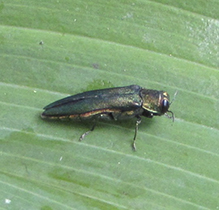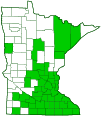emerald ash borer (EAB)
(Agrilus planipennis)
Conservation • Description • Habitat • Ecology • Distribution • Taxonomy
|
|
||||||||||||||
Pest Status |
|
| Global | Emerald ash borer was first detected in Moscow, Russia in 2003. Since then, it has continued to spread west. It is expected to reach central Europe between 2031 and 2036. |
| United States | On October 8, 2003, the USDA Forest Service imposed a quarantine on emerald ash borer. It prohibited the interstate movement of all firewood and other regulated items out of infected areas. The USDA removed the quarantine effective January 14, 2021. An emerald ash borer female can fly up to 100 miles in her lifetime. The quarantine had not been effective in preventing the spread of the beetle into adjacent areas. |
| Minnesota | On November 1, 2023, the Minnesota Department of Agriculture declared a quarantine to prevent the further spread of emerald ash borer. It prohibits the importation of firewood and other regulated articles into the state, and the movement of those articles from quarantined areas to uninfected areas. |
Description |
Emerald ash borer, also known by the acronym EAB, is an exotic, invasive, small to medium-sized, metallic wood-boring beetle. It is native to northeastern Asia, including China, Mongolia, North and South Korea, Japan, Taiwan, and far eastern Russia. Emerald ash borer was first detected in North America in 2002 in Detroit Michigan. It was probably imported in the wood of a shipping crate in the late 1990s. It has spread rapidly since its introduction. It now occurs from Maine to northern Georgia, west to Minnesota and northeastern Texas. It was discovered for the first time in Minnesota on May 14, 2009, in South Saint Anthony Park in St. Paul. It is now common in southeastern Minnesota, and it is continuing to spread in the state. Eight infected counties were added in 2023 and six infected counties were added in 2024. Emerald ash borer larvae feed exclusively on black ash, green ash, and white ash. They feed on the inner bark (cambium), creating serpentine tunnels (galleries) that interrupt the flow of food. They eventually girdle and kill the branch or tree. They have killed tens of millions of trees in the eastern United States, including over five million trees in a 3,000 square mile area of Michigan. Adults are active in Minnesota from May 1 through September 30. They are found in deciduous forests and woodlands, in parks, and in urban and residential areas, anywhere ash trees are found. Adults are 5⁄16″ to 9⁄16″ (7.5 to 14 mm) in length. Males are smaller than females. The body is bullet shaped – rigid, narrow, and elongate. It is bright emerald green overall, with varying amounts of coppery, red, or gold metallic reflections. Rarely individuals may be bluish or reddish. The amount of metallic reflection varies with the angle and strength of the light, so that the overall color can change as the observer shifts positions. The head is flat and is slightly tucked beneath the first segment of the thorax (prothorax). The eyes are black and kidney shaped. The antennae are short and have 11 segments. Segments 1 through 3 are cylindrical. Segments 4 through 11 are sawtoothed. The mouthparts are projected downward. The upper plate covering the prothorax (pronotum) is wider than long. It is usually bright green with both yellow and coppery or bronze reflections. On the underside of the male there is fine, pale, erect hair over the entire thorax. The female does not have that hair. The wing covers (elytra) are colored similar to the pronotum but are usually darker and greener. The upperside of the abdomen is bright metallic red. EAB is the only Agrilus species in North America with this feature. The underside of the abdomen is also red. It is only visible when the elytra and hindwings are raised. In the male, there is a well-developed raised ridge (carina) on the underside of the last abdominal segment. The carina continues as a short spine at the tip of the abdomen. |
Size |
Total length: 5⁄16″ to 9⁄16″ (7.5 to 14 mm) |
Similar Species |
Habitat |
Deciduous forests and woodlands, in parks, and in urban and residential areas, anywhere ash trees are found |
Ecology |
Season |
May through July |
Behavior |
|
Life Cycle |
The larvae overwinter in the tree. They take one or two years to mature, depending on the temperature. Adults chew their way out in the spring, leaving a characteristic ⅛″ (3 mm) wide, D-shaped hole. |
Larva Food |
Cambium of black ash, green ash, and white ash |
Adult Food |
|
Damage |
The larvae feed on the inner bark (cambium), creating serpentine tunnels (galleries) that interrupt the flow of food. They eventually girdle and kill the branch or tree. They have killed millions of trees in the eastern United States, including over five million trees in a 3,000 square mile area of Michigan. |
Biological Pest Control |
Woodpeckers consume large numbers of EAB larvae, and they are the most effective biological control agents. Native parasitic wasps can parasitize EAB larvae, but they usually kill less than 5% of the larvae on an infected tree. Four parasitic wasp species from Asia have been introduced into North America in an effort to manage EAB: Oobius agrili, Tetrastichus planipennisi, Spathius agrili, and Spathius galinae. |
Taxonomy |
|
Order |
Coleoptera (Beetles) |
Suborder |
Polyphaga (Water, Rove, Scarab, Long-horned, Leaf, and Snout Beetles) |
Infraorder |
Elateriformia |
Superfamily |
Buprestoidea |
Family |
Buprestidae (jewel beetles) |
Subfamily |
Agrilinae |
Tribe |
Agrilini |
Subtribe |
Agrilina |
Genus |
|
Subgenus |
|
Subordinate Taxa |
|
|
|
Synonyms |
|
Agrilus feretrius Agrilus marcopoli Agrilus ulmi |
|
Common Names |
|
emerald ash borer |
|
Glossary
Cambium
A thin layer of soft growing tissue composed of unspecialized cells in the stems of plants. It provides new xylem to the inside and new phloem to the outside.
Carina
An elevated keel or ridge.
Elytra
The hardened or leathery forewings of beetles used to protect the fragile hindwings, which are used for flying. Singular: elytron.
Pronotum
The exoskeletal plate on the upper side of the first segment of the thorax of an insect.
Prothorax
The first (forward) segment of the thorax on an insect, bearing the first pair of legs but not wings.
Visitor Photos |
||
Share your photo of this insect. |
||
This button not working for you? |
||
Alfredo Colon |
||
 |
||
Babette Kis |
 |
Emerald Ash Borer Agrilus planipennis Agrilus planipennis, emerald ash borer, Milwaukee, WI. Photo was taken on June 16, 2017. The year the photo was taken was one of the first years I saw this beetle. |
MinnesotaSeasons.com Photos |
||
|
||
|

Slideshows |
|

Visitor Videos |
||
Share your video of this insect. |
||
This button not working for you? |
||
|
Other Videos |
||
All About the Emerald Ash Borer and Treatments to Combat it! |
About
Oct 25, 2020 Agrilus planipennis, also known as the Emerald Ash Borer or EAB, was accidentally introduced into North America and has damaged and killed tens or even hundreds of millions of Ash Trees (genus Fraxinus). Native to north-eastern Asia, this wood-boring beetle feeds on the inner vascular system of Ash trees and prevents them from moving water and nutrients along the trunk. Over time, the trees are damaged to the point of death. North American Ash trees like the White Ash and Green Ash are declining in fast numbers, and many ecosystems have been dramatically altered because of this insect. There are some ways to combat this bug and prevent it from spreading including insecticides and pesticides. Scientists are researching the problem and will hopefully arrive at solutions that will allow Ash trees to make a full recovery in our forests and bottomlands. In this documentary, I cover the Emerald Ash Borer's life cycle, how they damage trees, how to detect signs of an infestation, treatments to use against them, and some current scientific research. |
Bay 101: Emerald Ash Borer |
About
Aug 24, 2016 The emerald ash borer is an invasive insect that is killing ash trees as it spreads across the United States. Colleen Kenny, a forester with the Maryland Forest Service, and Paula Shrewsbury, a professor at the University of Maryland, talk about the efforts being used to slow down the emerald ash borer and save ash trees—which have an important role in protecting water quality. Produced by Will Parson |
Identifying Emerald Ash Borer |
About
Jun 9, 2021 Learn more about the signs and symptoms associated with the invasive emerald ash borer. Created by Ryan Bohannon, Graduate Research Assistant. |
Emerald Ash Borer |
About
Aug 7, 2012 Meet the emerald ash borer, a tiny green beetle that has killed millions of ash trees in southern Ontario, parts of Quebec and the northeastern United States since it was first detected in the Windsor, Ontario area in 2002. |

Visitor Sightings |
||
Report a sighting of this insect. |
||
This button not working for you? |
||
Alfredo Colon |
Location: Albany, NY |
 |
Alfredo Colon |
Location: Albany, NY |
 |
MinnesotaSeasons.com Sightings |
||
|

Created: 1/7/2024 Last Updated: © MinnesotaSeasons.com. All rights reserved. |


